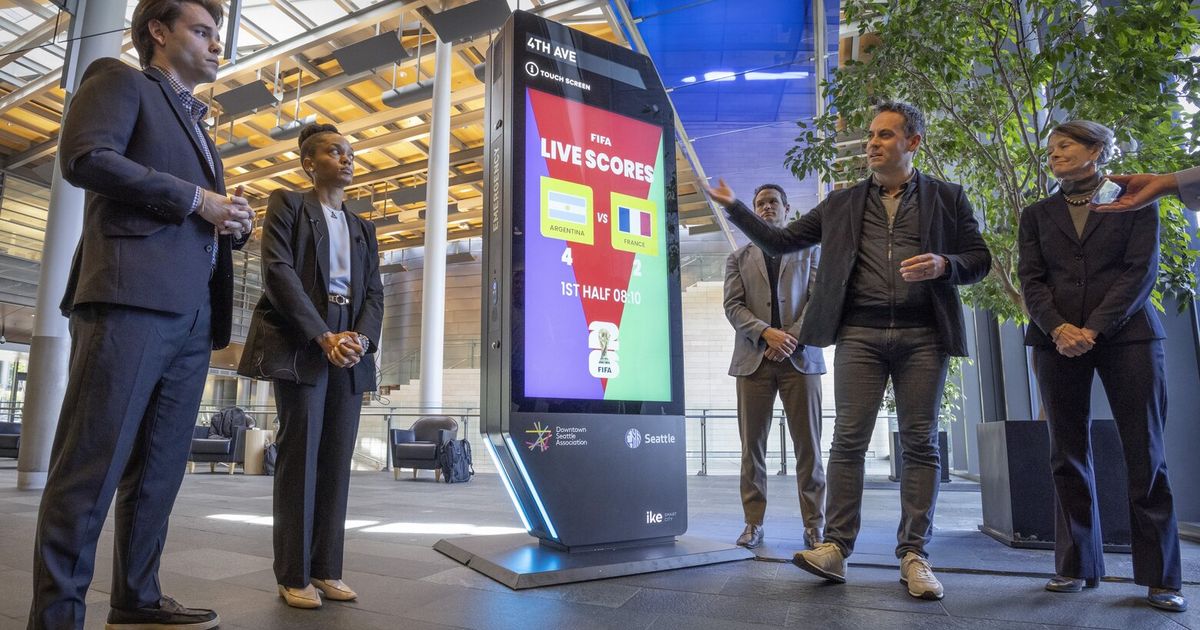Angela Robertson has no regrets about moving her brewery into Bellevue’s Spring District.
“We have a lot of new customers, so a lot of new people have discovered us,” said Bellevue Brewing Company co-owner Robertson as an early lunch crowd was beginning to trickle into the brewpub on an early-fall Friday.
In July 2022, the company relocated the craft brewery, taproom and restaurant from its original location in an industrial area of Bellevue into 9,100 square feet of leased space in the middle of the Spring District, an Eastside development that includes 800 rental apartments, retail and several office buildings mostly owned or leased by Facebook’s parent company, Meta.
The Spring District has been among the largest and top-profile developments in Seattle’s metro area for more than a decade. Landing the brewpub was a big win for the developer, Wright Runstad & Company, whose vision has been to build an urban village in the industrial Bel-Red area on 36 acres just north of Lake Bellevue, once a distribution center for Safeway supermarkets.
But all has not gone according to plan. The Spring District has been slow to fill retail spots, and the entire development now faces uncertainty over Meta’s plans for its sprawling office campus.
Meta was once the reason for accelerating the Spring District’s development, according to Greg Johnson, co-CEO of Wright Runstad.
But for now, Johnson said, Meta’s plans for the buildings are not clear.
“They have yet to decide when they are going to occupy,” Johnson said in an interview.
The social media giant leases or owns most of the office buildings in the development. It currently leases and occupies two buildings — Block 16 and Block 24 — that were opened in 2021. It also bought the buildings — Block 7 and 20 — that were slated to be REI headquarters in 2020. Earlier this year, the developer completed the 330,000-square-foot Block 6 building, which Meta spokesperson Tracy Clayton confirmed the company is trying to sublease.
By mid-next year, Wright Runstad will deliver two more large office towers, Block 5 and Block 13, to Meta. Asked about the future of these two buildings, Clayton deferred to a general company statement on its office footprint. It says Meta is “prioritizing making focused, balanced investments to support our most strategic long-term priorities and lead the way in creating the workplace of the future.”
The statement adds that the company is “firmly committed to the area as evident by the nearly 8,000 employees who call the region home.”
After more than three years of remote work and hundreds of layoffs in the Puget Sound area, Meta’s strict return-to-office policy took effect last month, requiring employees to be in the office three days a week. In late September, Clayton said “a healthy amount of our employees” was working on the Spring District campus.
Meta’s plans for the new buildings could have an impact on future building in the district. Wright Runstad had plans to build several more office buildings in a third phase of the development, and it has designed a future 11-story, 339,200-square-foot office building. For now, the developer is done building office towers until market conditions improve.
Johnson said he would like to see Meta’s buildings occupied to give more life to the neighborhood but is not troubled by what the tech giant ultimately decides to do.
“We are not on any particular schedule to develop more buildings and never have been,” Johnson said. “It has always been, ‘Let’s lean in when we feel the market is getting stronger,’ and we were fortunate in that we had the luxury of pumping the brakes and sitting tight if the market isn’t there. And right now, it isn’t there.”
Overall market conditions
As Meta tries to sublease its space in the Spring District, it is facing challenging office-leasing conditions across the Seattle area, which might mean office space could remain unoccupied.
Even at the Spring District, more office space is available. The University of Washington, which leases the 96,000-square-foot GIX building for a graduate and professional development program, is also trying to find tenants to occupy unused space. Currently the UW shares the three-story multiuse building with a handful of startups.
According to Trevor Youngren, managing director in Cushman & Wakefield’s Seattle office, large tech companies have been shedding space and consolidating in downtown Seattle, Bellevue and the suburbs.
“The suburbs are definitely doing better than Seattle but, sadly, that is kind of a low bar,” Youngren said.
On the Eastside, Big Tech leasing spiked during the COVID-19 years, but that has really slowed down over the past 12 to 18 months, he added.
However, it is possible to find office tenants, according to Youngren, and quality buildings in good areas have a much better chance to get leased. Small and midsized tech companies have been growing, and leasing space for satellite offices, especially in Bellevue.
For example, logistics company Flexport signed a 56,000-square-foot sublease at Skyline Tower in the Bellevue commercial district in the spring, according to Cushman & Wakefield’s research. A few months later, Australian software firm Atlassian also signed a direct deal for just over 15,000 square feet in the same building.
“Things have slowly started to turn over the past couple of months, and there is actually decent activity right now from a leasing perspective,” Youngren said. Tenants, though, still have a lot of options.
Shopping around
Attracting retail has been another challenge for the Spring District. A deli, a fitness studio, a Wells Fargo branch and a day care are some of the businesses that have moved in to the development.
But several vacant retail spots have yet to be leased in occupied buildings. In one of the apartment buildings near the brewpub, there’s 3,000 square feet of vacant street-level space suitable for a future restaurant. Across from the yet-to-open Sound Transit train station, a two-story “retail pavilion” with space for four retailers has been empty since the building was completed in late 2021.
For now, apartment buildings seem to fill some void in the otherwise-quiet neighborhood. Johnson said the three apartment complexes on campus, Sparc, Arras and AMLI, are fully occupied except for temporary vacancies created each month by tenant turnover.
Raja Rawal, an Amazon worker who moved with his wife into the Sparc apartment complex a year ago, said he likes the neighborhood, but would like more choices for a night out.
“I would say something like a bowling alley or stuff like that,” Rawal said, while walking his dog near the brewpub. “Having a couple of more options to eat would be a good idea as well because we just have this one restaurant here.”
The plan is to fill in the empty spaces with restaurants, coffee shops, a wine bar, possibly a yoga studio and a bike shop, among other shops that will complete the neighborhood. But Johnson said several factors have made it challenging to secure retail commitments.
He said retailers have also been wary of signing leases since the pandemic. Also, Sound Transit isn’t scheduled to start running the trains to the district until the spring.
Johnson said that the development also has been selective in targeting retailers.
“Our posture is that we still want to lease it to the right mix of shops that are going to help it feel like a neighborhood as opposed to doing a bunch of nail salons,” he said. “Leasing space to a chiropractor is not going to help it feel like a neighborhood.”
Tracy Cornell, the development’s retail leasing agent, said she’s convinced that the spots will all eventually fill up.
“We got the Bellevue Brewing Company deal done during a very difficult time and climate,” Cornell noted. “There are a lot of people who like the Spring District and are very curious about it.”
Cornell said the neighborhood’s retailers will also draw a lot of customers from surrounding neighborhoods in Bellevue, like the Wilburton neighborhood.
“Having the light-rail station and having Meta there is nice but it is really the density of the neighborhood that is going to support the Spring District long term,” she said. “There are a lot of things in our favor, but I think the neighborhood around the Spring District is probably the No. 1 driver. All the other things are just kind of nice cherries on top.”
Meta’s plans and the slow progress of the Spring District haven’t been a concern of Robertson, who says she’s focused on building up a solid lunch crowd. She says she’s drawing a lot of customers from within the development, but also some of her old patrons have been stopping in from other parts of the city.
The brewpub has a big patio, which is popular with customers and spills out into an open area with shade trees and tables.
“It is quite a draw,” she said. “People enjoy sitting outside, and it is right by the park so the kids can go play.”
While she’s not too worried about what Meta is going to do with its buildings, she said she would welcome serving more of their workers.
“I certainly hope they want to come over here for happy hour,” she said.
















